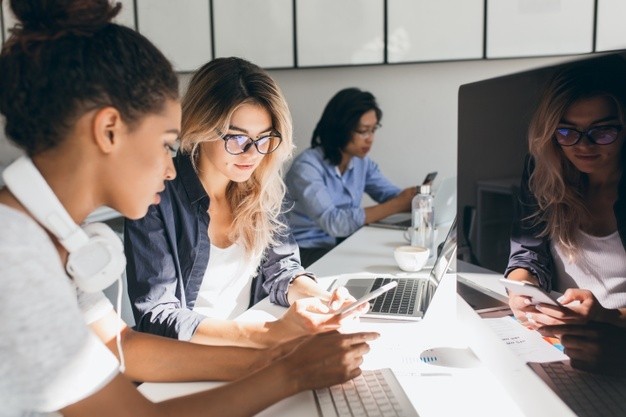Insight Blog
Agility’s perspectives on transforming the employee's experience throughout remote transformation using connected enterprise tools.
8 minutes reading time
(1600 words)
Generational Work Differences and Managing Generation-Z in the Workplace | Updated Guide 2022
In this new era of remote working, employers need to ensure they properly understand Gen -Z. So, how does Gen Z differ in the workplace in 2022?
The difference in a generation is indicated by the differences in behavior and viewpoint between individuals who were born in different eras. Each generation grows up in a distinct environment, and as a result, their employment expectations may change. Silent generation members are known for their economically conservative behavior. In comparison, the baby boomers are known for liberal fiscal tendencies. Moreover, the older generations like traditional communication, but Gen Zers are extremely tech-dependent and comfortable utilizing social media sites.
There can be unclear internal communications, and they lead to problems in handling age differences in the workplace. When it comes to accomplishing employment tasks, each generation may have its own preferences and expectations. Previous generations may be more respectful of authority than the current generation. They have been noticed to be extremely loyal to the company's value. In addition, communication medium differs from generation to generation, so it is likely that non-tech-savvy employees will overlook information.
Managing generation Z in the workplace
The parents of generation Z are the starting point. As Gen X employees began to have children, they were resolved to be active, present, and knowledgeable, as well as to combat the media's never-ending onslaught of kid risks. Consequently, "helicopter parenting" arose, leading to increased levels of preparation and oversight for everything from food and exercise to playdates, education, extracurricular activities, and downtime.
While investing in recruitment marketing and providing online recruiting materials is a fantastic method to prepare new recruits, it isn't enough to ensure that they are totally immersed in your business culture the moment they walk in the door. Prepare a new recruit onboarding checklist and schedule lots of opportunities for social interaction.
For day-to-day communication, generation Z employees prefer email, text, and social media, and they utilize a variety of platforms to consume a lot of information rapidly. Is it time to broaden your employee communication channels? Do you utilize intranet software, email, and professional social media to communicate with your staff, or do you still expect them to call each other?
Generation Z employees are the epitome of perpetual learners, which is a good thing because businesses are already looking for ways to help them improve their soft skills. Training and professional development programs motivate generation Z employees, and they look for prospects for future progression inside the company.
Generation Z employees want constant mentoring and quick response, as well as internal mobility, despite their aversion to being micromanaged. So, you should start considering leaving your "promotion-from-within" strategy and put in place the structures and processes to allow internal mobility. Otherwise, it may lead to losing key employees to competitors.
Include continuing education and unconscious bias training in your company's curriculum, and assess your diversity recruitment strategy to ensure it meets Gen Z's standards.
Don't expect generation Z employees to just sit back and accept the income they're provided, especially with pay equity in the news. They are aware of their value and are willing to battle for it. Know which employee benefits are most appealing to generation Z employees, and balance your benefits package with a mix of standard advantages (medical and financial), student loan aid, wellness benefits, and appealing maternity and paternity policies.
Tips for managing gen z employees in the workplace
Generation Z employees have been noticed to be not obsessed with job titles. They are more interested in supporting their company's growth and success than in climbing the corporate ladder. Don't get too excited about titles, but keep in mind that these are people who will love to accept new responsibility and leadership. You can follow these tips to manage generation Z employees in the workplace.
- -Use technology in the workplace
- -Do not focus too much on health concerns
- -Improve company culture
- -Get the right generation Z workers in your team
- -Work on improving job perks
Managing millennial and Gen z
Recognition
Generation Z and millennial employees want to be heard and noticed. So, inquire as to how they prefer to work. Include them in discussions that will have an influence on them. Even if final choices do not go their way, people will be more involved if they believe their input is valued.
Use social intranet
Plan to leverage new technology for everything from brainstorming to billing as generation Z and millennial becomes the majority of the workforce. Use a social intranet to talk and exchange files whether you're working from home or in a shared office environment. Demonstrate that you aren't caught in the traditional ways of doing things by cultivating an innovative culture.
Improve engagement
When Generation Z and millennial employees can discover a sense of purpose at work, they are more engaged. They want to know why their job is vital to the organization and how their project fits into the bigger plan. They also want to know that their firm shares its values and represents something other than its products or services. Connect their work to the why behind it wherever feasible.
Freedom
Younger generations flourish when they can work freely, despite prejudices. That's not to say they won't require some direction, but micromanaging generation Z and millennial workers is likely to drive them away. Kids need more opportunities if you want them to develop problem-solving abilities and make them creative.
Generational work differences
We have seen several technological advancements, so it has resulted in two completely distinct life experiences between generation Z and other generations. A computer at each workstation was not customary when Baby Boomers first started working, but it is a must-have for Millennials and Generation Z.
Consequently, the current employee experience depends on several expectations. Moreover, this is what it takes to keep each employee engaged. When you throw in a pandemic, the picture changes even further, as each generation deals with this life-changing period differently.
In order to understand differences in generations in the workforce, it's important to know the demographics of the workforce, as well as how those generations envision the future, the job they perform now, and how they perceive their coworkers.
Millennials are the largest workforce, and they have been at the forefront of the employee experience's change in recent years. This is significant to highlight at such a critical juncture since as we adjust to a "new normal" in post-pandemic existence, this generation will play a significant role in molding it.
Despite all of the rhetoric about younger generations splurging on expensive coffee and avocado toast, the reality does not match. These generations are extremely concerned about their long-term financial well-being, which may be a result of having lived through many economic disasters at a young age.
Although the three workplace generations we covered have numerous differences, there are some things that they all agree on. Family is extremely important to all three generations. Furthermore, all three generations agree that training and feedback are critical to a successful job. Finally, change is difficult. Most individuals dislike change, whether they are young, elderly, or somewhere in between. Allow coworkers to know each other and how they function, as it is incredibly valuable to all three levels of influence, regardless of your personal beliefs and preferences.
Here is what employers can do to manage generational work differences:
- -Accept generation differences, but do not generalize
- -Improve employee engagement and know them as individuals
- -Implement their feedback
- -Provide mentorship opportunities
Multi-generational workforce
Having a diverse variety of ages on your team provides value to your company. Younger workers are used to fast-evolving technology and responding to the changes that it brings. Similarly, more experienced employees have information from their years of experience that may help them make better decisions. Increased productivity is achieved by combining new ideas with knowledge gained from experience.
Job obligations might be seen differently by different generations. Sharing viewpoints inside and across teams helps to encourage creativity by bringing a diverse set of skills and expertise together. Problems are solved more creatively when many viewpoints and expertise are combined. When it comes to dealing with obstacles and conflict, our life experiences have an impact on how we relate to and interact with people. As a result, teams with a range of ages may provide a variety of solutions to challenges.
Each generation's understanding and strengths help the company better prepare for its future leadership demands. Tacit knowledge is kept within the organization in the form of a strong internal talent pipeline. The emphasis is on internal advancement rather than external recruiting.
There are likely to be generational variances in preferred communication strategies and tone interpretation. There are several ways to contact staff, including email, instant messaging, phone, and video calls. The ideal strategy to connect with team members and minimize communication breakdowns necessitates serious thought.
Learning how to manage generational work differences in employees can be challenging, but it can also be lucrative for your company. Taking advantage of age-related difficulties creates a strong talent pipeline to help businesses stay afloat.
Categories
Blog
(2626)
Business Management
(321)
Employee Engagement
(211)
Digital Transformation
(175)
Intranets
(120)
Growth
(119)
Remote Work
(61)
Sales
(48)
Collaboration
(37)
Culture
(29)
Project management
(29)
Customer Experience
(26)
Knowledge Management
(21)
Leadership
(20)
Comparisons
(6)
News
(1)
Ready to learn more? 👍
One platform to optimize, manage and track all of your teams. Your new digital workplace is a click away. 🚀
Free for 14 days, no credit card required.




















